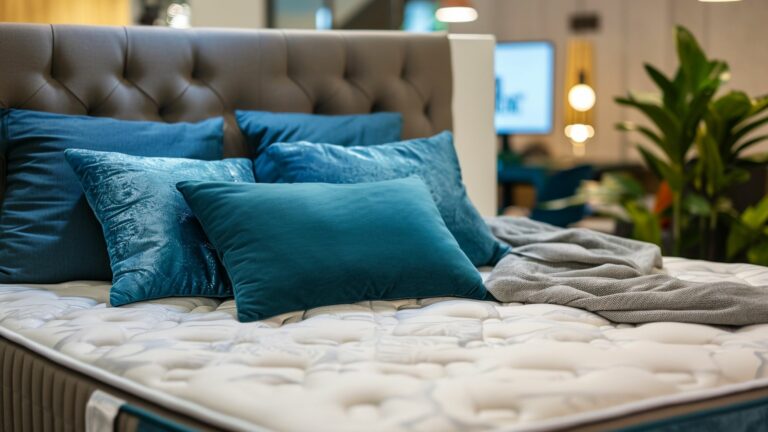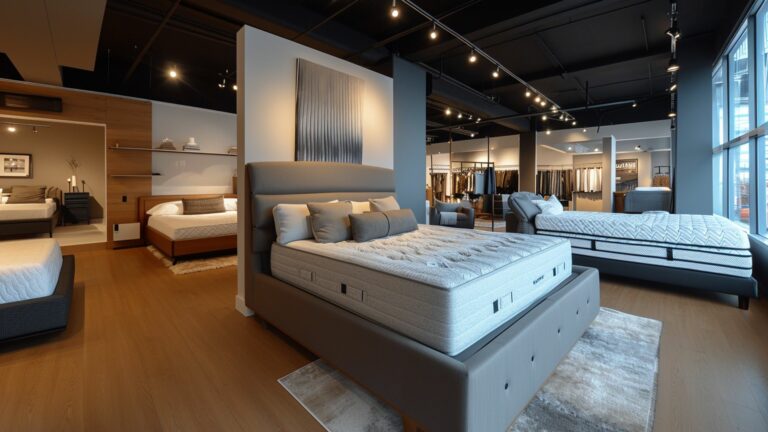In the heart of Minnesota, the mattress industry mirrors the state’s diverse consumer base, catering to a broad spectrum of preferences, from traditional innerspring models to cutting-edge memory foam and hybrid options.
Considering Minnesota’s geography and population, this means that the mattress market is both large and varied, serving city residents, as well as residents of less populated towns and the countryside.
Find a Mattress Near Me in Minnesota
A key feature of the mattress industry in Minnesota is the presence of either major national brands and local manufacturers. This combination provides Texans an extensive variety of mattresses to meet every sleep preference, body type, and budget. Local manufacturers often emphasize customizability and personalization, utilizing materials that are suited to the state’s climate, such as cooling gel foams, breathable fabrics, and wool, to improve sleep quality.
The mattress retail scene in Minnesota encompasses a variety of stores, from large furniture stores and specialty mattress shops to online retailers. The emergence of online mattress companies has greatly influenced the Minnesota market, offering convenience and competitive pricing. These companies frequently offer generous trial periods and free returns, solving the traditional hesitation around buying mattresses without testing them firsthand.
Eco-consciousness and sustainability are growing in importance to Minnesota consumers, leading to a rising demand in organic and natural mattress options. These products, made from materials like organic cotton, wool, and natural latex, are aimed at environmentally conscious shoppers seeking to reduce their ecological footprint.

Moreover, the competitive nature of the Minnesota mattress market means that retailers often provide sales and promotions, making high-quality mattresses easier to acquire to a wider audience. The state’s mattress industry also thrives thanks to Minnesota’s strong economy and housing market, as new residents and homeowners support steady demand.
About Minnesota
Minnesota ( MIN-ə-SOH-tə) is a state in the Upper Midwestern region of the United States. It is the 12th largest U.S. state in area and the 22nd most populous, with over 5.75 million residents. Minnesota is known as the “Land of 10,000 Lakes” for having more than 14,000 bodies of fresh water covering at least ten acres each; roughly a third of the state is forested; much of the remainder is prairie and farmland. More than 60% of Minnesotans (about 3.7 million) live in the Minneapolis–Saint Paul metropolitan area, known as the “Twin Cities”, the state’s main political, economic, and cultural hub and the 16th-largest metropolitan area in the U.S. Other minor metropolitan and micropolitan statistical areas include Duluth, Mankato, Moorhead, Rochester, and St. Cloud.
Minnesota, which gets its name from the Dakota language, has been inhabited by various Indigenous peoples since the Woodland period of the 11th century BCE. Between roughly 200 and 500 CE, two areas of the indigenous Hopewell tradition emerged: the Laurel complex in the north, and Trempealeau Hopewell in the Mississippi River Valley in the south. The Upper Mississippian culture, consisting of the Oneota people and other Siouan speakers, emerged around 1000 CE and lasted through the arrival of Europeans in the 17th century. French explorers and missionaries were the earliest Europeans to enter the region, encountering the Dakota, Ojibwe, and various Anishinaabe tribes. Much of what is now Minnesota formed part of the vast French holding of Louisiana, which the United States purchased in 1803. After several territorial reorganizations, the Minnesota Territory was admitted to the Union as the 32nd state in 1858. Minnesota’s official motto, L’Étoile du Nord (“The Star of the North”) is the only state motto in French; this phrase was adopted shortly after statehood and reflects both the state’s early French explorers and its position as the northernmost state in the contiguous U.S.











